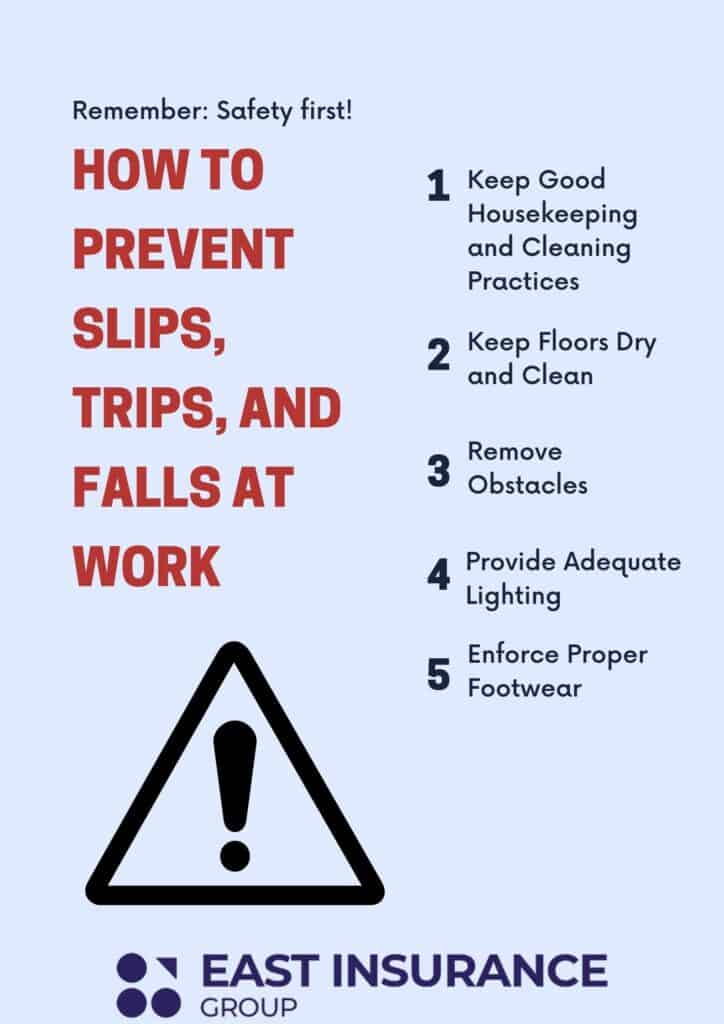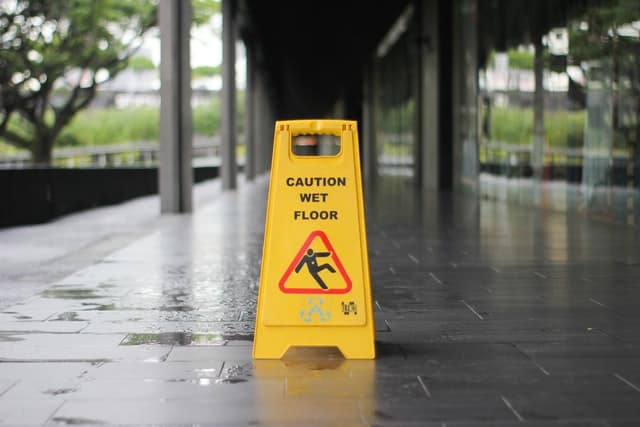According to National Safety Council, the top three leading causes of preventable injury-related death are poisoning, motor vehicle accidents, and falls. According to the same source, no other preventable cause of death accounts for more than 5% of the total.
On the other hand, emergency department visits are dominated mainly by injuries related to slips, trips, and falls, accounting for 32% of all preventable nonfatal injuries. In 2019, 880 workers died in falls at the workplace, while 244,000 were injured and had to take days off work. Falls can happen everywhere, including at desk jobs, but construction workers are most at risk for fatal falls from height.
Is preventing slips, trips, and falls possible? In short, yes. There are ways to protect your workers and company from financial losses caused by potential claims and losing employees due to work-related injuries.
Here’s everything you need to know about creating a safe work environment and slip, trip, and fall prevention.
How Do Slips, Trips, and Falls Happen?
When it comes to preventing falls in the workplace, it’s important to know that the majority of falls are the result of slips and trips. Another portion of falls comes from falling from a height, including falls from ladders, roofs, downstairs, or jumping.
Slips usually happen when there is too little traction or friction between the footwear and the walking surface. Some of the most common causes of slips are:
- Weather hazards
- Wet or oily surfaces
- Occasional spills
- Unanchored rugs
- Walking surfaces without the same degree of traction in all areas
Trips, on the other hand, happen when your foot hits an object which causes you to lose balance and fall. Some of the most common causes of trips are:
- Poor lighting
- Clutter in hallways
- Obstructed view
- Open bottom drawers
- Uneven walking surfaces
How to Prevent Slips, Trips, and Falls at Work
As we mentioned above, employee injuries can be a big financial hit to any organization. To help you in preventing slips, trips, and falls in the workplace, we gathered several steps you can take to minimize the risks.

Keep Good Housekeeping and Cleaning Practices
The first step in slip, trip, and fall prevention is to understand that housekeeping is a crucial part of safety at work. Good housekeeping and cleaning practices include:
- Immediate cleaning of all spills
- Marking wet areas and spills
- Mopping or sweeping debris from floors
- Removing obstacles from walkways
- Keeping walkways free of clutter
- Closing file cabinets or storage drawers
- Covering cables that cross walkways
- Securing mats and carpets that don’t lay flat
- Making sure all light bulbs and switches are working
Furthermore, proper cleaning is an excellent opportunity to conduct risk assessments simultaneously. These two activities should be performed as a routine in the workplace, not only after an accident. One of the best ways to prevent slips, trips, and falls is to create a plan.
First of all, think about assigning specific responsibilities to individuals or teams. Also, make sure you highlight that each employee is responsible for picking up after themselves and ensuring their workspace is clean.
Secondly, once you assign the duties to your employees and write down the routine, make sure you post the cleaning plan in a common area where everyone can see it and read it. Creating a plan to prevent slips, trips, and falls in the workplace takes a little bit of your time, but it pays off to be as proactive as possible.
Keep Floors Dry and Clean
When it comes to preventing falls in the workplace, mopping and spills are just a few situations when floors can get wet or sticky and create a potential incident at work. To prevent slips and falls, make sure you always put out a “wet floor” sign after spills and mopping.
Also, make sure you have moisture-absorbent mats to keep floors dry if outside water frequently seeps in. You can add anti-skid adhesive tapes that provide additional traction on slippery surfaces and work especially well if there are slight inclines.
Remove Obstacles
In the workplace, anything can be a trip hazard if it’s left on the floor. That includes equipment, work materials, and everyday clutter. These obstacles are usually found on stairways, doorways, on the floor, and around corners. As a part of preventing slips, trips, and falls, you should always keep the workplace free of these obstacles. One of the best ways to do it is to create a policy to regularly check areas to ensure your workplace is free from clutter.
Here are a few simple ways to keep your workplace free from obstacles:
- Don’t leave cables and wires lying across floors if not in use
- Close all drawers when not in use
- Keep hallways and storerooms clean and free from clutter
- Don’t leave files, boxes, briefcases lying on the floor
Provide Adequate Lighting
One of the common causes of slips, trips, and falls at work is bad lighting. Especially if the workplace is a construction site, every part must be adequately lit at all times during work hours. However, adequate lighting is also important in other industries, which means that all walkways, stairs, hallways, basements, and ramps need to be well lit.
Furthermore, make sure that all of your employees know they need to turn on the lights first when they enter a dark room. To make the process easier, place all light switches close to the door. Last but not least, make sure that all bulbs and cords are repaired immediately when needed.
Proper Footwear
Regardless of the industry you work in, proper footwear is vital when it comes to preventing slips, trips, and falls. In some industries, employees are required to wear specialized footwear to help them prevent incidents.
In case safety shoes aren’t required, employees need to consider their footwear. To avoid slipping in the shop, your footwear should be non-slip, with a lot of traction. If you wear heels, you need to ensure they won’t get caught on the edge of the rug or other uneven surfaces. Finally, you should always make sure that your shoelaces are tied properly to avoid slips, trips, and falls.
How to Protect Your Business Against Slips, Trips, and Falls
As mentioned above, the financial impact of slip and fall hazards can be massive, depending on the circumstances. Even if an employee experiences a minor inconvenience, employers suffer a loss of productivity when they are off the clock.
When it comes to preventing slips, trips, and falls in the workplace, you should consider having business insurance to cover customer and non-employee claims, as well as workers’ compensation insurance that protects your employees.
East Insurance Group can help you choose the best policy that works perfectly for your specific business needs. Contact one of our insurance agents today, and we will be happy to hear more about what you need to insure.

